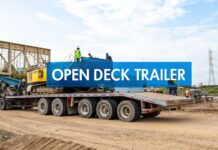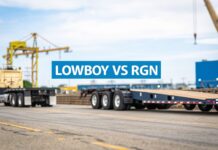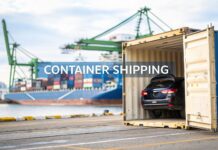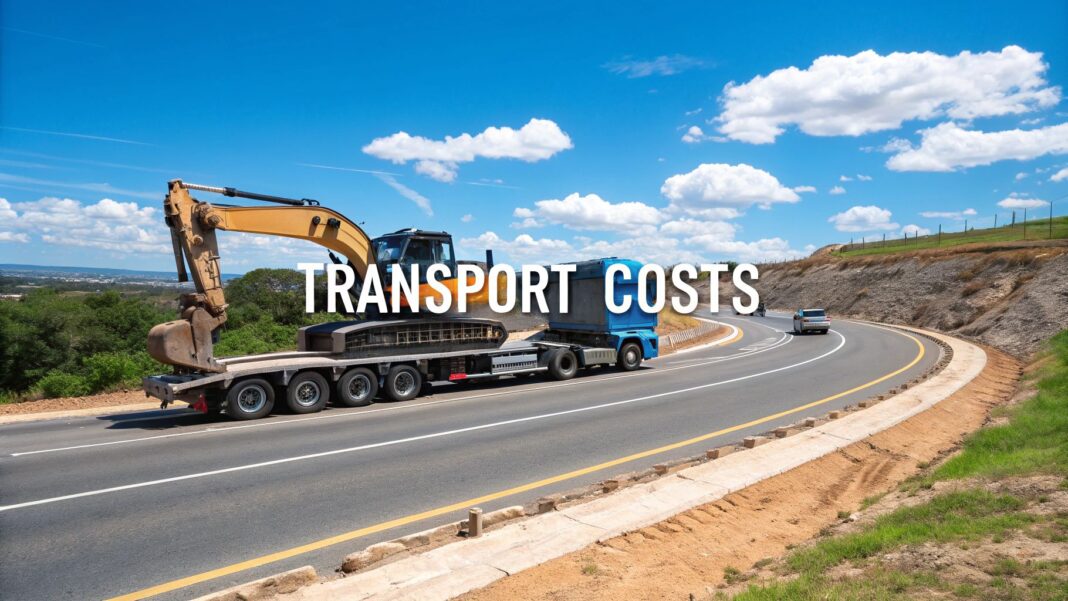
When budgeting for heavy equipment transport cost, the industry average of $1.50 to $5.00 per mile is a common starting point. However, this range is just a preliminary estimate. The final invoice is a direct result of your equipment's specific dimensions, its total weight, and the transport distance.
What to Expect for Heavy Equipment Transport Cost
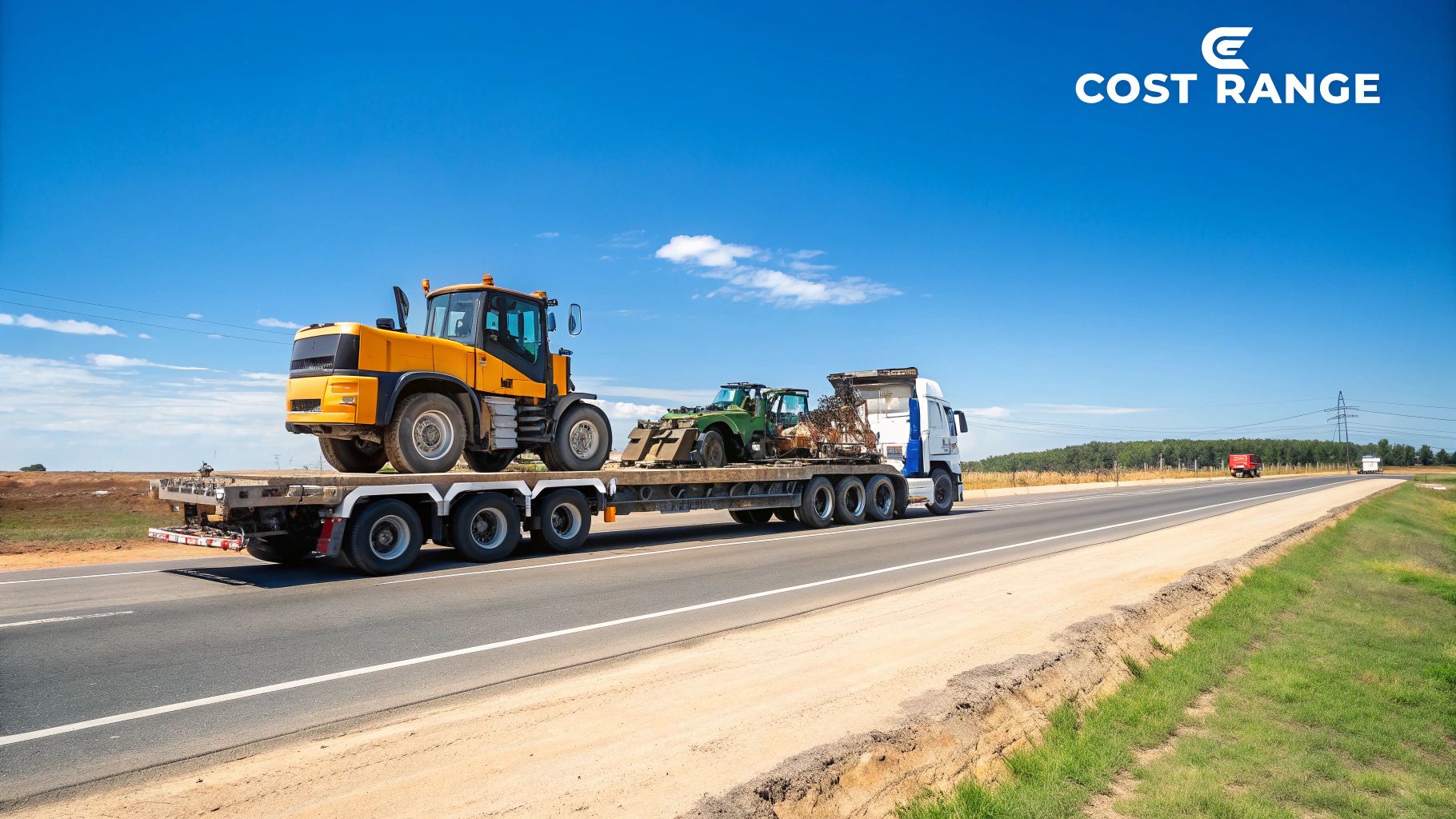
Determining the exact cost of shipping heavy equipment requires a detailed analysis, much like calculating postage for a large, irregular package. While a standard letter has a predictable cost, a massive, heavy crate requires careful consideration of its dimensions, weight, and destination. The same logic applies to heavy machinery transport.
A simple cost-per-mile figure doesn't capture the full scope of the operation. The logistics involve specialized trailers, a complex web of state-by-state permits, and often, pilot cars to ensure safe passage. Each of these elements is a critical line item on the final quote, turning a simple move into a detailed logistical task. To understand the full process, it’s best to consult with professional heavy equipment transport services who can provide a comprehensive breakdown.
Key Factors That Shape Your Transport Quote
To get a realistic cost estimate, you need to understand the variables carriers analyze when creating your quote. While every shipment is unique, a core set of factors consistently determines the final price.
This table breaks down the primary components that influence a custom transport estimate.
| Cost Factor | Impact on Price | Actionable Insight |
|---|---|---|
| Equipment Dimensions | High | An oversized bulldozer requires a specialized lowboy trailer and permits, increasing costs significantly compared to a smaller skid steer. Provide exact specs to avoid over-quoting. |
| Travel Distance | High | A 1,500-mile cross-country haul will have a higher total cost but a lower per-mile rate than a 200-mile regional trip. Long-hauls dilute fixed costs. |
| Permits & Escorts | Medium to High | Moving an overweight crane might require state permits and two escort vehicles, adding hundreds or thousands to the invoice. This is a non-negotiable legal requirement. |
| Route Complexity | Medium | A route through mountainous terrain or dense urban areas often costs more than a straightforward journey on interstate highways. Carriers factor in fuel, time, and risk. |
| Urgency & Season | Low to Medium | Urgent shipments or booking during peak construction season can lead to higher rates due to limited carrier availability. Book in advance to lock in better pricing. |
Understanding these core elements empowers you to anticipate final shipping costs, prepare an accurate budget, and avoid unexpected charges.
How Equipment Size and Distance Drive Your Quote
When calculating the cost of shipping heavy equipment, two factors dominate the equation: the machine's size and the transport distance. Moving a compact skid steer loader across town is a routine task. Hauling a 40-ton excavator across state lines, however, is a complex logistical challenge with a correspondingly higher price tag.
These two variables are the foundation of your shipping quote. They determine the type of trailer required, the necessary permits, the optimal route, and ultimately, the final cost. The larger and heavier your equipment, the more specialized the transport solution becomes, escalating both complexity and price.
This infographic illustrates the direct relationship between equipment specifications and travel mileage.
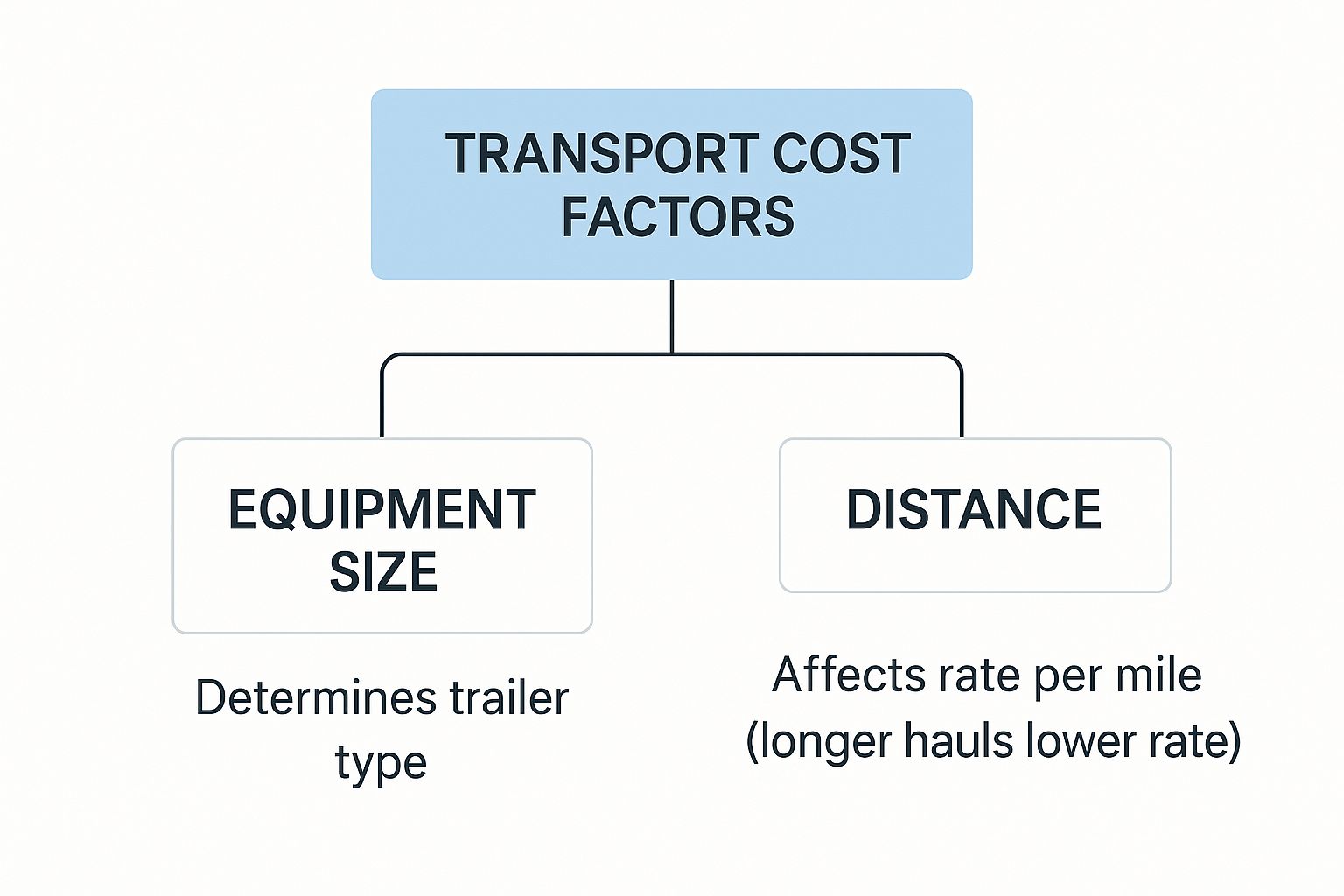
As shown, the equipment's size dictates the trailer type, while the distance establishes the per-mile rate. This two-part formula is the standard model used by transport companies to generate your quote.
Matching the Trailer to the Machine
A transport specialist's first questions will always be about your equipment's precise dimensions and weight. This information is critical for selecting the correct trailer to ensure a safe, legal, and damage-free haul. Choosing the right trailer is not a matter of preference; it's a fundamental requirement.
Standard Flatbeds: Ideal for common equipment within legal load limits—typically under 8.5 feet wide and 8.5 feet tall. As the most versatile and available option, they are the most cost-effective choice for standard loads.
Step-Decks & Lowboys: When a machine exceeds the height limit for a flatbed, step-decks and lowboys are the solution. Their lower deck height provides additional vertical clearance, allowing for the transport of equipment up to 12 feet tall without needing expensive overheight permits.
Removable Gooseneck (RGN) Trailers: For the heaviest machinery like large excavators, bulldozers, or cranes, an RGN is often the only option. The trailer's neck detaches and lowers to the ground, creating a ramp for drive-on loading. This specialized functionality makes RGNs a more expensive but necessary choice for oversized equipment.
The choice of trailer is a primary cost driver. An RGN is a specialized, less common piece of equipment, and its higher operating cost is directly reflected in your shipping quote. For a detailed breakdown, our guide on heavy cargo weights and shipping services explains how these factors are precisely calculated.
The Logic of Cost Per Mile
While distance is a major factor, its impact on the per-mile rate can be counterintuitive. The cost-per-mile often decreases as the total distance increases.
A short haul of 200 miles might cost $5.00 per mile. In contrast, a long-haul trip of 1,500 miles could see the rate drop to $2.50 per mile. While the total invoice is higher for the longer trip, the cost becomes more efficient on a per-mile basis.
This occurs because significant costs—such as loading, securing, permit processing, and initial planning—are front-loaded. On a short trip, these fixed expenses are spread across fewer miles, inflating the per-mile rate. On a long haul, they are diluted over a much greater distance, resulting in a lower per-mile cost.
The specific route is the final variable. Navigating around low bridges, avoiding roads with weight restrictions, or bypassing urban congestion can add miles and complexity, directly impacting the final invoice.
The Hidden Costs of Specialized Transport Needs
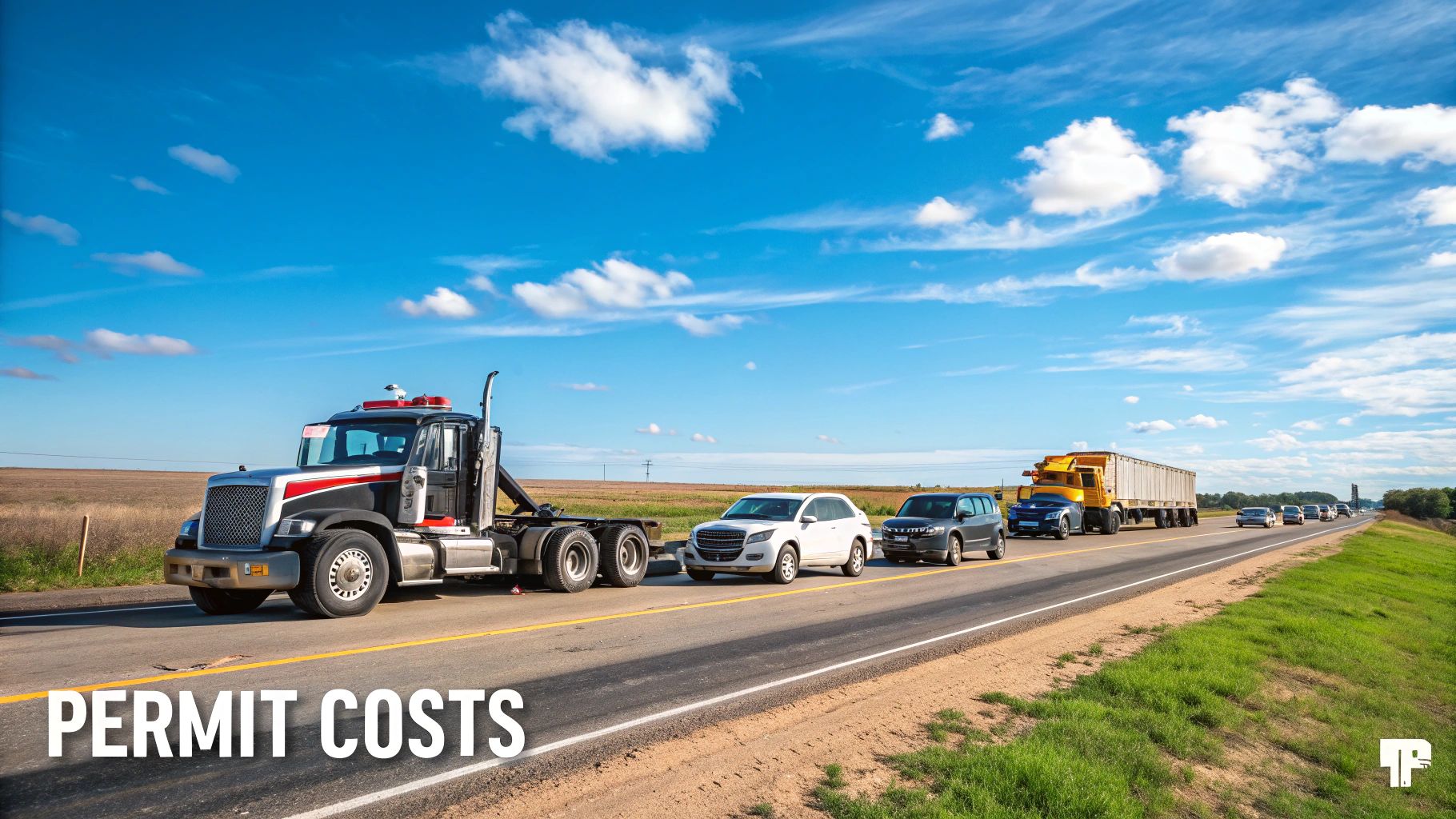
Transporting standard-sized equipment is straightforward. However, once your machine exceeds legal size or weight limits, you enter the realm of specialized transport, which introduces a new layer of mandatory costs.
Any machine wider than 8.5 feet, taller than 13.5 feet, or part of a load exceeding 80,000 pounds is classified as "oversized" or "overweight." This classification triggers a series of legal requirements, including special permits and escort vehicles, designed to ensure public safety and protect infrastructure.
The World of Oversize Permits
An oversize permit is a government-issued document authorizing travel along a specific, pre-approved route. Transportation authorities meticulously plan these routes to avoid hazards like low overpasses, bridges with weight limits, or narrow urban streets incapable of accommodating a large load.
Permit costs vary significantly by state. One state may charge a flat $150 fee, while another could demand thousands based on the equipment's specific dimensions and weight. For a multi-state journey, these permit fees accumulate quickly.
Actionable Tip: There is no national "oversize" permit. Your transport provider must secure a separate permit for every state the shipment passes through. Each permit adds a distinct cost to your final bill.
When Pilot Cars Become Mandatory
For exceptionally large loads, permits alone are insufficient. States mandate pilot cars (escort vehicles) to accompany the shipment. These escorts act as the truck driver's forward observers, warning oncoming traffic, identifying potential obstacles, and assisting with navigation through challenging sections.
The regulations for escorts are precise. For example, a load exceeding 12 feet in width may require one pilot car. If it surpasses 14 feet in width, two escorts—one in front and one behind—are often mandatory. These services are typically billed per mile or per day and represent a significant, non-negotiable expense.
Consider this practical comparison:
Scenario A: Shipping a Standard Dozer. A typical bulldozer that fits within legal dimensions can be loaded onto a standard flatbed and transported without special permits. Your cost is primarily driven by mileage and the carrier's base rate.
Scenario B: Shipping a Massive Crane. A large mobile crane, often over 12 feet wide and weighing 100,000+ pounds, is a different logistical challenge. It requires a specialized multi-axle trailer, oversize/overweight permits for each state, a route survey, and at least one pilot car for the entire journey. These requirements can easily double or triple the final cost compared to the standard dozer.
Understanding these mandatory layers is crucial for accurate budgeting. To see how trailer selection is directly linked to these needs, learn more about RGN trailer transport and its vital role in moving oversized machinery.
Real-World Shipping Costs for Common Equipment
While cost-per-mile averages provide a useful baseline, the specific type of machine you are moving is a primary determinant of the final price. To move from theoretical estimates to a practical budget, let's examine some real-world cost benchmarks for common equipment.
Use these figures as a guide, but remember that your final quote will vary based on the exact route, season, and carrier availability.
Estimated Transport Cost by Equipment Type and Distance
This table provides a practical snapshot of typical price ranges, illustrating how equipment size and haul distance interact to determine the final cost. Moving a small skid steer a few hundred miles is fundamentally different from transporting a massive dozer cross-country.
| Equipment Type | Weight Range (tons) | Short Haul (Under 500 miles) | Long Haul (Over 1000 miles) |
|---|---|---|---|
| Skid Steer Loader | 3 – 5 tons | $500 – $1,200 | $1,500 – $2,500 |
| Standard Backhoe | 7 – 11 tons | $800 – $1,800 | $2,000 – $3,500 |
| Mid-Size Excavator | 20 – 25 tons | $1,500 – $3,000 | $3,500 – $6,000+ |
| Large Bulldozer (D8) | 35 – 45 tons | $2,500 – $5,000 | $6,000 – $10,000+ |
As illustrated, costs escalate significantly with increases in size and distance, reflecting the added layers of logistical complexity required for heavier, larger equipment.
Breaking Down the Numbers
What drives the substantial price difference between shipping a skid steer and a D8 bulldozer over the same distance? The answer lies in the logistical requirements triggered by size and weight.
A skid steer represents a simple transport. It fits on a standard flatbed trailer, requires no special permits, and is a routine job for most carriers.
In contrast, a large bulldozer is a complex logistical operation. Its size and weight almost always exceed legal road limits, classifying it as an oversized load.
This classification triggers a cascade of requirements, each adding to the final cost:
- Specialized Trailer: A standard flatbed is insufficient. A more expensive and less common trailer, such as an RGN (Removable Gooseneck) or a lowboy, is required.
- Permits: Oversize and overweight permits must be acquired and coordinated for every state on the transport route.
- Escort Vehicles: Depending on its width, the dozer may legally require one or two pilot cars to ensure safe transit.
Each of these items is a significant cost center. The heavy equipment transport cost for a large machine is not just a function of mileage; it's a reflection of the specialized equipment, permits, and expertise needed to move it safely and legally.
What’s the Market Got to Do With It?
The price you pay for heavy equipment transport is influenced by more than just your machine's specifications and the transport distance. It is also directly tied to the broader economic market, operating on the principles of supply and demand.
During periods of economic growth, construction and industrial activity surge, creating high demand for heavy haul carriers. Since the number of specialized trucks and certified drivers is finite, this imbalance—high demand and limited supply—inevitably drives prices upward.
Supply and Demand: A Real-World Example
The dynamic is similar to booking air travel during a holiday weekend. The aircraft and seats remain the same, but with everyone wanting to fly simultaneously, airlines can command premium prices. The heavy haul industry operates on the same principle.
During peak construction season or following the passage of major infrastructure legislation, carriers are inundated with transport requests. They can charge higher rates because their services are in high demand. Conversely, during slower periods, carriers become more competitive with their pricing to keep their fleets active. This insight provides a strategic advantage: if your timeline is flexible, shipping during an off-peak period can result in significant savings.
Market Growth and the Tech Factor
The demand for heavy equipment transport is on a consistent growth trajectory. The global market, recently valued at approximately $10 billion, is projected to reach $15 billion by 2033. This growth is primarily driven by global infrastructure spending, ensuring that carrier availability will remain a key pricing factor. Currently, North America dominates this market, accounting for 35% of global revenue. You can explore these transport market trends to inform your shipping strategy.
Technology is also reshaping the industry. Leading carriers are investing in advanced routing software and fleet management systems to maximize operational efficiency. While these tools can reduce fuel consumption and optimize schedules, the investment cost is factored into the overall rate structure.
Ultimately, the quote you receive is a snapshot of the market at a specific moment. It reflects not only the details of your shipment but also the prevailing economic climate, seasonality, and the technology powering the industry. Understanding this broader context allows you to plan strategically rather than simply react to pricing.
Proven Strategies to Reduce Your Transport Costs
Once you understand the factors that comprise a shipping quote, you can take strategic steps to reduce your final cost. Lowering heavy equipment transport costs is not about cutting corners on safety but about smart planning that enhances carrier efficiency.
Before seeking savings, establish a clear financial baseline by tracking all your business expenses effectively. This provides a solid foundation, showing where your money is allocated and highlighting opportunities for cost reduction.
With a clear budget, a few proactive measures can significantly impact the quotes you receive.
Your Cost-Saving Checklist
Implement these practical strategies to secure a better rate on your next shipment. Each action addresses a key cost factor, helping you avoid surprise fees and negotiate a fair price.
Provide Exact Dimensions: Never estimate. Supplying the carrier with precise weight, height, width, and length is essential. Inaccurate or estimated dimensions force them to quote for a larger, more expensive trailer to cover potential discrepancies. This can also lead to significant surcharges if the equipment does not match the provided specs at pickup.
Clean and Prep Your Equipment: A machine covered in mud or debris is heavier and more difficult to handle safely. Before the carrier arrives, ensure your equipment is clean. Secure or remove all loose attachments to prevent loading delays and minimize the risk of damage during transit.
Book Well in Advance: Last-minute bookings almost always come at a premium. Providing a carrier with two weeks or more of notice allows them to integrate your shipment into their most efficient routes. A well-planned load is a more profitable one for the carrier, and these savings are often passed on to you.
Flexibility is your greatest negotiation tool. If you can be flexible with your pickup or delivery dates, carriers can more easily fit your shipment into their existing schedules. This helps them eliminate "deadhead" miles (driving an empty truck), an operational efficiency they are often willing to reward with a lower rate.
Ultimately, clear communication and proactive planning are your most effective cost-reduction tools. These simple efforts empower you to directly influence the final price and ensure you receive excellent service without overpaying.
When you need reliable and secure shipping for your valuable machinery, We Will Transport It handles all the logistics with expert care. Get your hassle-free quote today at https://www.wewilltransportit.com.

